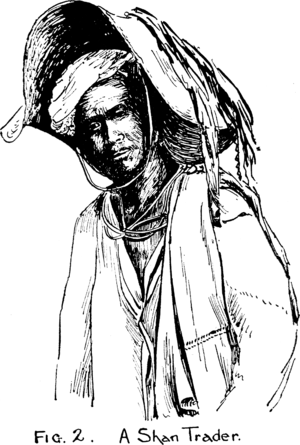Chinese invasions in A.D. 1582 and 1604 put a final end to the Mao Shan dynasty, and Shan history then becomes merged in Burmese. The Shan principalities, although restive under the rule of Burma, never threw off the yoke.
The town of Mogaung still bears every appearance of having once been a large and thriving centre, much bigger than Bhamo. It suffered greatly in wars with Burma in the seventeenth and eighteenth centuries, and its sack by the Kachins in 1883 would have brought permanent ruin had it not been for the British annexation in 1886.


The Appearance of the Shans and their Dress.
The Shans resemble both the Siamese and Burmese in general appearance, but are frequently fairer. They are muscular and well formed, having eyes almost lineal in position, a small nose and a large mouth. Their hair is long, lank and black, and they practise tatu.
The dress of the men generally consists of a pair of trousers and a jacket, the pattern of the former varying considerably amongst different tribes, sometimes being like the Chinese with well-defined legs, sometimes, especially among the well-to-do classes, being so voluminous as to look like a skirt. White turbans are worn in the North, variously coloured ones in the South, whilst the Chinese Shan wears blue and the Shan trader of British territory a broad-brimmed, limp, woven grass hat of Chinese manufacture (Fig. 2).
The men usually tatu with isolated patterns in red on the chest, back and arms, in some cases continuing the tatuing as far as the middle of the calf.
The Shan women (Fig. 3) do all the indoor and much of the field work, they are strong, healthy, and fair-skinned; being fine specimens of Eastern female beauty.
